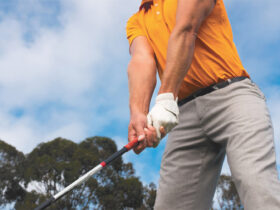 As millions of avid golfers get ready for another season of pars and bogeys, they should be aware of potentially serious foot problems that can result from years of playing the game.
As millions of avid golfers get ready for another season of pars and bogeys, they should be aware of potentially serious foot problems that can result from years of playing the game.
Although golf is not considered a rigorous sport, the physical act of repeatedly swinging a golf club in practice and on the links can lead to a condition known as hallux limitus, a jamming and deterioration of the big toe joint. The movement and weight transfer that occur during the swing’s follow through can cause this problem and other chronic foot ailments.
When golfers follow through on their swing, they can overextend the big toe joint on the back foot. Those who have played the game avidly for several years eventually can wear out the cartilage or jam the big toe joint. The likely outcome, if left untreated, is painful arthritis in the big toe, which would make it very difficult to continue playing golf.
Golfers who have pain and swelling around the big toe joint or have less mobility in this area than other parts of the foot should visit a foot and ankle surgeon for an examination and appropriate treatment. A history of trauma to the big toe area and bone structure also can precipitate the condition. Individuals with a long first metatarsal bone (big toe), for example, are more susceptible to joint compression and hallux limitus.
If golfers experience pain in the big toe area when playing, they should consider it a warning sign that intervention is necessary before the joint becomes arthritic. In most situations, orthotics can be prescribed to provide relief, but others with advanced cases may require surgery.
Commonly associated with golfing is tendinitis. Overuse of the tendon responsible for stabilizing your big toe can cause inflammation and eventual weakening or rupture. Treatment for tendinitis can take you away from golfing for a few weeks.
Another foot problem that is common in golfers is a neuroma or pinched nerve at the bottom of the foot. The weight transfer to the front foot that occurs in the follow through applies pressure that, over time, can cause a pinched nerve.
I also advises golfers not to wear shoes that have a spike located directly beneath the ball of the foot. The pressure from that single spike, magnified by the several thousand steps taken during an average round, can cause intense pain and swelling in the ball of the foot, known as metatarsalgia. Any pair of golf shoes can be made more foot friendly without sacrificing traction by removing the poorly located spikes.
Heel pain, known as plantar fasciitis, is also seen in golfers. As the sport is not as vigorous, most individuals do not “warm up” or stretch. Add on lack of supportive shoe gear, and we are begging to have heel pain.
All of these concerns can be addressed with appropriate shoe gear or orthotics. Come in today to discuss the mechanics of your feet and how custom inserts would benefit you. To learn more contact your local foot and ankle doctor.
Sahiba Singh
DPM, AACFAS
For more information, you may contact Dr. Sahiba Singh at Family Foot & Leg Center at (239) 430-3668.
Family Foot & Leg Center has 8 locations throughout Collier, Lee, & Charlotte Counties to quickly resolve all your foot and ankle problems.









